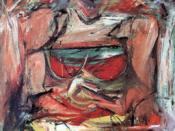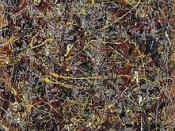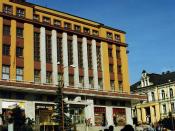Jackson (Paul) Pollock, was an American painter, who was a leader of the abstract expressionist movement. He was born in Cody, Wyoming, and studied at the Art Students League in New York City with Thomas Hart Benton. Pollock spent several years traveling around the country and sketching. In the late 1930s and early 1940s he worked in New York City on the Work Projects Administration Federal Art Project. His early paintings, in the naturalistic style of Benton, depict the American scene realistically. Between 1943 and 1947 Pollock, influenced by surrealism, adopted a freer and more abstract style.
After 1947 Pollock worked as an abstract expressionist, developing a technique that was called action-painting in which the artist drips paint and commercial enamels from sticks onto huge canvases that stretched on the floor. By doing this Pollock produced complex interlaced patterns of color, such as "Full Fathom Five and Lucifer" (van der Vlugt 2003).
After 1950 his style changed again, as he crisscrossed raw white canvas with thin lines of brown and black pigment. One of his famous paints is called "number one" (Bruce 2004); which is located at the Museum of modern Art in New York City. The piece is "Oil on canvas, 68 inches x 104 inches" (Sullivan 2004). By looking at the painting, you can take many things away from it. What ever your imagination required was the tempo that Pollack tried to make you see. "Jackson Pollock's Number One shows how much paint can be "unrestricted, unexpected, uncontrolled" (Lore-Elbel-Bruce 2003). "Number one" is a piece that looks very intrigue. By the perception of eye, it looks like the painting has many layers because of the way he painted on top of dry paint, and the way he used different color schemes to make that effect.
Willem de Kooning's...


